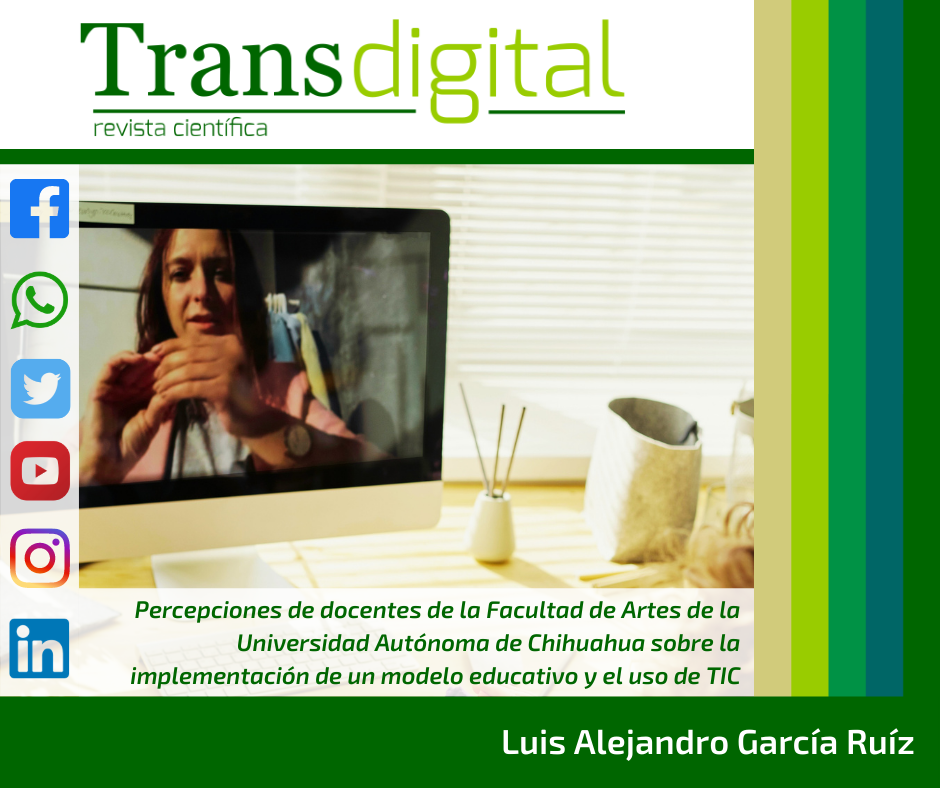Teacher’s perceptions about ICT and the implementation of a new educational model in the Faculty of Arts of the Autonomous University of Chihuahua
DOI:
https://doi.org/10.56162/transdigital51Keywords:
Educational innovations, Technology of the information and communication, educational models, Grounded Theory, university reformAbstract
The Autonomous University of Chihuahua (UACH) is undergoing a university renovation, a new educational model is in the process of being implemented. This competency-based model demands the use of ICT. In order to understand the context of the new model in the Faculty of Arts of this university and the use of ICT, in-depth interviews were conducted with eleven teachers of the institution and the information obtained was processed through grounded theory method. Although the process of renovating the educational model is ongoing and can yet be modified, teachers are perceiving a risk of simulation. The lack of effective communication, the saturation of some teachers, and the lack of substantial administrative changes frame these perceptions. Change management strategies are necessary to be able to include educational technology in an integral way and transform the teaching practice that tends to maintain its traditional forms. Attitudinal and ideological changes must occur for a correct renewal of the educational model, but they must be supported by an administrative transformation that fosters an equitable work and academic environment.
References
Álvarez, N. (2019). El docente universitario como sujeto y objeto de la innovación educativa. Dilemas Contemporáneos: Educación, Política y Valores, edición especial (2), 1–14. https://doi.org/10.46377/dilemas.v27i1.1585
Durán, M., Prendes, M., y Gutiérrez, I. (2019). Certificación de la Competencia Digital Docente: propuesta para el profesorado universitario. Revista Iberoamericana de Educación a Distancia, 22(1), 187-205. http://dx.doi.org/10.5944/ried.22.1.22069
Flores, Ó., y del Arco, I. (2013). Nativos digitales, inmigrantes digitales: rompiendo mitos. Un estudio sobre el dominio de las TIC en profesorado y estudiantado de la Universidad de Lleida. Bordón. Revista de Pedagogía, 65(2), 59–74. https://doi.org/10.13042/brp.2013.65204
Guerrero Bejarano, M. (2016). La Investigación Cualitativa. INNOVA Research Journal, 1(2), 1–9. https://doi.org/10.33890/innova.v1.n2.2016.7
Kenett, R. (2007). Cause?and?Effect Diagrams. En Encyclopedia of statistics in quality and reliability. John Wiley. https://doi.org/10.1002/9780470061572.eqr413
Liao, C. (2016). From Interdisciplinary to Transdisciplinary: An Arts-Integrated Approach to STEAM Education. Art Education, 69(6), 44–49. http://10.1080/00043125.2016.1224873
Mascarell Palau, D. (2019). Implementación y uso de las TIC. Dispositivos móviles en educación en artes. Un estado de la cuestión. Revista de Comunicación de la SEECI, (50), 73-86. http://doi.org/10.15198/seeci.2019.50.73-86
Moreno Olivos, T. (2010). El currículo por competencias en la universidad: más ruido que nueces. Revista de la educación superior, 39(154), 77-90. http://publicaciones.anuies.mx/pdfs/revista/Revista154_S2A1ES.pdf
Noguera Fructuoso, I. (2015). How Millennials are changing the way we learn: the state of the art of ICT integration in education. RIED: Revista Iberoamericana de Educación a Distancia. 18 (1), 45-65. http://dx.doi.org/10.5944/ried.18.1.13800
Okuda, M., & Gómez, C. (2005). Metodología de investigación y lectura crítica de estudios. Revista Colombiana de psiquiatría, 34(1), 118-124. https://doi.org/10.1016/j.rcp.2018.08.002
Pérez Gómez, A. (1997). Historia de una reforma educativa: estudio múltiple de casos sobre la reforma experimental de tercer ciclo de E.G.B. en Andalucia. Díada.
Radclyffe Thomas, N. (2008). White heat or blue screen? Digital technology in art & design education. International Journal of Art & Design Education, 27(2), 158-167. https://doi.org/10.1111/j.1476-8070.2008.00571.x
Riis, S. (2017). ICT Literacy: An Imperative of the Twenty-First Century. Foundations of Science, 22(2), 385-394. https://doi.org/10.1007/s10699-015-9456-5
Quezada, R. (2014). Reflexiones sobre las bases y procedimientos de la Teoría Fundamentada. Ciencia, docencia y tecnología, 25(48), 149-172. http://www.revistacdyt.uner.edu.ar/spanish/cdt_48/documentos/005cdt_48.pdf
Trencher, G., Yarime, M., McCormick, K., Doll, C. y Kraines, S. (2014). Beyond the third mission: Exploring the emerging university function of co-creation for sustainability. Science and Public Policy, 41(2), 151-179. https://doi.org/10.1093/scipol/sct044
Universidad Autónoma de Chihuahua. (2019). Renovación Universitaria. Universidad Autónoma de Chihuahua. https://renovacion.uach.mx/presentacion.html
Varguillas, C., y Ribot, S. (2007). Implicaciones conceptuales y metodológicas en la aplicación de la entrevista en profundidad. Laurus, 13(23), 249-262.

Downloads
Autor de correspondencia
El autor de correspodencia se identifica con el siguiente símbolo: *Published
Versions
- 17-08-2021 (5)
- 16-05-2021 (1)
How to Cite
License
Copyright (c) 2021 Luis Alejandro García Ruiz

This work is licensed under a Creative Commons Attribution 4.0 International License.
All articles in Transdigital are licensed under a Creative Commons Attribution 4.0 International License. Authors hold the copyright and retain publishing rights without restrictions.









